Papers by Richard B Carter
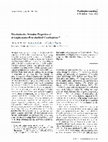
Psychopharmacology, 1980
Pigeons were trained to discriminate IM injections of 1.0mg/kg d-amphetamine from water, 5.6 mg/k... more Pigeons were trained to discriminate IM injections of 1.0mg/kg d-amphetamine from water, 5.6 mg/kg pentobarbital from water, or 1.0 mg/kg damphetamine from 5.6 mg/kg pentobarbital by requiring them to peck different response keys depending on which substance was administered prior to the session. Excellent stimulus control was achieved under all conditions with close to 100 ~ of the responses occurring on the injection-correlated key. In tests with doses different from those used in training, the percentage of responses on the drug key was directly related to drug dose. When d-amphetamine was given to birds trained to discriminate pentobarbital from water or when pentobarbital was given to birds trained to discriminate d-amphetamine from water, responding occurred predominately'on the water-correlated key. d-Amphetamine produced a dose-related antagonism of the effects of pentobarbital for birds trained to discriminate pentobarbital from water or from d-amphetamine. Rates of responding on the drug key were generally highest after administration of the drug doses used in discrimination training; but response rates were not systematically related to the percentage of responses occurring on the drug key. All birds were subsequently trained to discriminate a combination of 1.0 mg/kg d-amphetamine and 5.6 mg/kg pentobarbital from either 1.0 mg/kg d-amphetamine or 5.6 mg/kg pentobarbital alone, demonstrating that the discriminative stimulus properties of anaphetamine-pentobarbital combinations are different from either drug alone. Several of the drug effects reported were related to the drug discrimination that had been established.
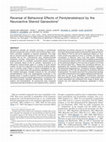
The Journal of Pharmacology and Experimental Therapeutics, Mar 1, 1998
Neuroactive steroids are naturally occurring or synthetically derived compounds many of which hav... more Neuroactive steroids are naturally occurring or synthetically derived compounds many of which have anticonvulsant, anesthetic, anxiolytic, analgesic or hypnotic properties. The major site of neuronal activity appears to be with a specific steroidsensitive site on the ␥-aminobutyric acid A receptor/chloride ionophore complex. Ganaxolone (3␣-hydroxy-3-methyl-5␣pregnan-20-one) is a synthetic neuroactive steroid protected from metabolic attack of the 3␣ position. Ganaxolone is an efficacious anticonvulsant agent in a variety of acute seizure models, as well as in electrical and chemical kindling models, and is currently under Phase II clinical investigation for epilepsy. A prior observation that ganaxolone appeared to reverse the marked behavioral changes induced by the convulsant pentylenetetrazol (PTZ) was systematically examined in the present study. A model to quantify PTZ-induced behaviors is described and used to evaluate ganaxolone in comparison with the anticonvulsants valproate, ethosuximide, clonazepam, diazepam and phenobarbital. All compounds were compared using dose equivalents based on their respective ED 50 values in
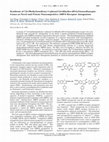
Journal of Medicinal Chemistry, 1998
A group of 7,8-(methylenedioxy)-1-phenyl-3,5-dihydro-4H-2,3-benzodiazepin-4-ones was synthesized ... more A group of 7,8-(methylenedioxy)-1-phenyl-3,5-dihydro-4H-2,3-benzodiazepin-4-ones was synthesized and assayed for antagonism of rat brain R-amino-3-hydroxy-5-methylisoxazole-4propionic acid (AMPA) receptors expressed in Xenopus oocytes. The benzodiazepinones inhibited AMPA-activated membrane current responses in a manner consistent with noncompetitive, allosteric inhibition of the receptor-channel complex. The most potent compound in the series was 1-(4-aminophenyl)-7,8-(methylenedioxy)-3,5-dihydro-4H-2,3-benzodiazepin-4-one (6), which had an IC 50 of 2.7 µM. For comparison, the reference compound GYKI 52466 (2) had an IC 50 of 6.9 µM. Compound 6 also had potent anticonvulsant activity in a mouse maximum electroshock-induced seizure (MES) assay: the ED 50 was 2.8 mg/kg iv, whereas the ED 50 for GYKI 52466 was 4.6 mg/kg iv. In contrast to a previous report, the 7,8-dimethoxy analogue of 6 was a low-potency AMPA antagonist (IC 50 >100 µM) and weak anticonvulsant (ED 50 >10 mg/kg iv). The benzodiazepinones described herein are potent noncompetitive AMPA receptor antagonists that could have therapeutic potential as anticonvulsants and neuroprotectants.
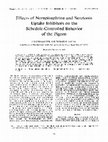
Pharmacology Biochemistry and Behavior, Mar 31, 1984
t:ffects of nore'pinephrine and serotonin uptake inhibitors on the ,gchedule-~'ontrolh,d behavior... more t:ffects of nore'pinephrine and serotonin uptake inhibitors on the ,gchedule-~'ontrolh,d behavior ~/'the pige~n. PHARMACOL BIOCHEM BEHAV 20(3) 391-395, 1984.--The effects of norlriptyline, amitriptyline, desipraminc, chlorimipramine, protriptyline, doxepin, nisoxetine, fluoxetine and iprindole were determined on responding by pigeons under a multiple fixed-ratio 30-response. fixed-interval 10-minute schedule of grain presentation. Those drugs which have been shown to block uptake of norepinephrine decreased fixed-interval quarter-life values. Those which are considered most selective as norepinephrine uptake inhibitors also increased overall fixed-interval responding. These increases in fixed-interval responding, both on local and overall rates, in pigeons appear to be due to the actions of these drugs to inhibit uptake of norepinephrine rather than to other actions.
Cheminform, 2010
1997 steroids steroids U 0300 17 -197 3α-Hydroxy-3β-(phenylethynyl)-5β-pregnan-20-ones: Synthesis... more 1997 steroids steroids U 0300 17 -197 3α-Hydroxy-3β-(phenylethynyl)-5β-pregnan-20-ones: Synthesis and Pharmacological Activity of Neuroactive Steroids with High Affinity for GABAA Receptors.

Journal of Pharmacology and Experimental Therapeutics
Epilepsy continues to be a significant clinical problem as current medications neither adequately... more Epilepsy continues to be a significant clinical problem as current medications neither adequately control seizures nor are free of untoward side-effects. Modulation of the neuroactive steroid site on the ␥-aminobutyric acid (GABA) A receptor complex may be an important new direction for pharmaceutical interventions in epilepsy. In this study we evaluated the protective actions of four neuroactive steroids, 3␣-hydroxy-5␣pregnan-20-one, the 3-methylated analog, ganaxolone (3␣hydroxy-3-methyl-5␣-pregnan-20-one), 3␣-hydroxy-5-pregnan-20-one and Co 2-1068 (3-(4acetylphenyl)ethynyl-3␣,21dihydroxy-5-20-one-21-hemisuccinate), against several standard convulsive tests in male, Swiss-Webster mice. Consistent with their GABAergic actions, the neuroactive steroids as well as diazepam and phenobarbital dose-dependently protected against clonic convulsions induced by pentylenetetrazol; the N-methyl-D-aspartate receptor antagonist, dizocilpine, was ineffective. In contrast to diazepam and phenobarbital, however, all of the neuroactive steroids and dizocilpine produced full protection against cocaine-induced convulsions. Some of
European Journal of Pharmacology
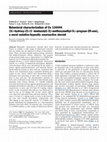
Psychopharmacology
Rationale: Neuroactive steroids have been shown to exhibit a wide range of behavioral activities ... more Rationale: Neuroactive steroids have been shown to exhibit a wide range of behavioral activities that are similar but not identical to those of benzodiazepines. These activities include anticonvulsant, anxiolytic and sedative-hypnotic effects. Objective: The purpose of the present study was to characterize Co 134444 (3αhydroxy-21-(1′-imidazolyl)-3β-methoxymethyl-5αpregnan-20-one), a novel sedative-hypnotic neuroactive steroid, in a variety of behavioral procedures. Methods: Anticonvulsant effects were determined by the ability to protect against pentylenetetrazol-and maximal electroshock-induced seizures in mice and rats. Anxiolytic-like effects were determined using a punished drinking procedure in rats. Ataxic effects were determined using a horizontal wire procedure in mice and a rotorod procedure in mice and rats. The discriminative stimulus effects were evaluated in rats trained to discriminate pregnanolone from vehicle. Results: Co 134444 exhibited oral anticonvulsant activity against pentylenetetrazol and maximal electroshock with ED 50 s of 9.8 and 20.6 mg/kg, respectively, in mice and 23.6 and 25.3 mg/kg, respectively, in rats. Anxiolytic-like efficacy was observed at a dose as low as 3.0 mg/kg, PO, in rats. Ataxic effects were observed with rapid onset and short duration. TD 50 s were 17.4 and 21.2 mg/kg orally in mice in the horizontal wire and rotorod procedures, respectively, and 39.0 mg/kg in rats using the rotorod. Co 134444 completely substituted for pregnanolone as a discriminative stimulus with little effect on response rate. Conclusions: Co 134444 exhibits a wide variety of behavioral effects; however, its rapid onset and short duration are consistent with its potential use as a sedative-hypnotic drug.
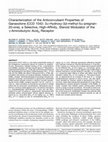
Journal of Pharmacology and Experimental Therapeutics
Ganaxolone (CCD 1042) is a 3-methyl-substituted analog of the endogenous neuroactive steroid 3␣-... more Ganaxolone (CCD 1042) is a 3-methyl-substituted analog of the endogenous neuroactive steroid 3␣-hydroxy-5␣-pregnan-20-one. Ganaxolone inhibited binding of the ␥-aminobutyric acid (GABA) A receptor-chloride channel ligand t-[ 35 S]butylbicyclophosphorothionate (IC 50 of 80 nM) and enhanced binding of the benzodiazepine site ligand [ 3 H]flunitrazepam (EC 50 of 125 nM) and the GABA site ligand [ 3 H]muscimol (EC 50 of 86 nM), consistent with activity as a positive allosteric modulator of the GABA A receptor. Electrophysiological recordings showed that, whereas nanomolar concentrations of ganaxolone potentiated GABA-evoked chloride currents in Xenopus oocytes expressing the human GABA A receptor subunits ␣11␥2 L , ␣21␥2 L or ␣31␥2 L , direct activation of chloride flux occurred to a limited extent only at micromolar concentrations. Ganaxolone was effective in nontoxic doses against clonic convulsions induced by s.c. pentylenetetrazol administration in mice and rats (ED 50 values of 4.3 and 7.8 mg/kg i.p., respectively). Ganaxolone also exhibited potent anticonvulsant activity against seizures induced by s.c. bicuculline (ED 50 of 4.6 mg/kg i.p.), i.p. TBPS (ED 50 of 11.7 mg/kg i.p.) and i.p. aminophylline (ED 50 of 11.5 GABA-containing neurons are the predominant inhibitory neural elements within the brain. Correspondingly, GABAmediated inhibition plays a critical role in the epileptic process by contributing to the termination of the ictal discharge and limiting the spread of hyperexcitability. Potentiation of GABAergic inhibitory function has therefore served as the rational basis for a number of programs targeted toward the discovery of novel antiepileptic agents .
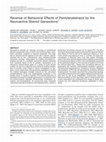
The Journal of pharmacology and experimental therapeutics, 1998
Neuroactive steroids are naturally occurring or synthetically derived compounds many of which hav... more Neuroactive steroids are naturally occurring or synthetically derived compounds many of which have anticonvulsant, anesthetic, anxiolytic, analgesic or hypnotic properties. The major site of neuronal activity appears to be with a specific steroid-sensitive site on the gamma-aminobutyric acidA receptor/chloride ionophore complex. Ganaxolone (3 alpha-hydroxy-3 beta-methyl-5 alpha-pregnan-20-one) is a synthetic neuroactive steroid protected from metabolic attack of the 3 alpha position. Ganaxolone is an efficacious anticonvulsant agent in a variety of acute seizure models, as well as in electrical and chemical kindling models, and is currently under Phase II clinical investigation for epilepsy. A prior observation that ganaxolone appeared to reverse the marked behavioral changes induced by the convulsant pentylenetetrazol (PTZ) was systematically examined in the present study. A model to quantify PTZ-induced behaviors is described and used to evaluate ganaxolone in comparison with the ...
ChemInform, 1997
1997 steroids steroids U 0300 17 -197 3α-Hydroxy-3β-(phenylethynyl)-5β-pregnan-20-ones: Synthesis... more 1997 steroids steroids U 0300 17 -197 3α-Hydroxy-3β-(phenylethynyl)-5β-pregnan-20-ones: Synthesis and Pharmacological Activity of Neuroactive Steroids with High Affinity for GABAA Receptors.
Journal of Pharmacology and Experimental Therapeutics, Dec 1, 1999
Novel neuroactive steroids were evaluated for their effects on operant responding, rotorod motor ... more Novel neuroactive steroids were evaluated for their effects on operant responding, rotorod motor performance, and electroencephalogram recording in rats. Co 134444, Co 177843, and Co 127501 were compared with the prototypical ␥-aminobutyric acid A -positive allosteric modulators triazolam, zolpidem, pentobarbital, pregnanolone, and CCD 3693. Each of the compounds produced a dose-related decrease in response rates under a variable-interval 2-min schedule of positive reinforcement in an operant paradigm. In addition, all compounds produced a dose-related increase in ataxia and significant increases in nonrapid eye movement sleep in this experiment or
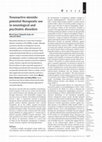
Trends in Pharmacological Sciences, 1999
Neuroactive steroids are a novel class of positive allosteric modulators of the GABA A receptor. ... more Neuroactive steroids are a novel class of positive allosteric modulators of the GABA A receptor. Although neuroactive steroids are endogenous neuronal modulators, synthetic entities with improved oral bioavailability have recently been developed. These compounds demonstrate efficacy as anticonvulsants against a range of convulsant stimuli and demonstrate anti-epileptogenic activity in a kindling model of epilepsy. Efficacy has also been reported in preclinical models of anxiety, insomnia, migraine and drug dependence. Clinical evidence to date is generally supportive of these findings and indicates that neuroactive steroids are generally well tolerated. Taken as a whole, current data suggest that neuroactive steroids could have a future role in clinical practice. In this article, Maciej Gasior, Richard Carter and Jeffrey Witkin review preclinical and clinical evidence that forms the basis for predicting the potential therapeutic application of neuroactive steroids.

Psychopharmacology, 1982
Nonopioid-dependent pigeons were trained to discriminate IM injections of 30.0 mg/kg naloxone fro... more Nonopioid-dependent pigeons were trained to discriminate IM injections of 30.0 mg/kg naloxone from water in the procedure in which 15 consecutive responses on one of two keys resulted in grain presentation. Naloxone-appropriate responding was maximal at doses of naloxone equal to and greater than the training dose. The onset of the naloxone discriminative cue was rapid (less than 5 min) and the duration of the cue was short (less than 60 min). Naltrexone (1.0-10.0 mg/kg). pentazocine (1.0-10.0 mg/kg), levallorphan (1.0-30.0 mg/kg), and nalorphine (3.0-30.0 mg/kg) produced dose-dependent increases in naloxone-appropriate responding, occasioning 100% naloxone-key selections. In contrast, cyclazocine, profadol, and diprenorphine, at doses up to those at which animals did not respond, produced only intermediate degrees of naloxone-appropriate responding. Morphine always produced selection of the water key. These results demonstrate that a pure opioid antagonist, such as naloxone, has discriminative stimulus effects in the nonopioid-dependent animals, that these stimulus effects are shared by certain other opioid antagonists, and that these effects are distinguishable from those produced by pure opioid agonists, such as morphine.
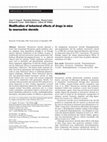
Psychopharmacology, 2000
Rationale: Neuroactive steroids represent a novel class of potential therapeutic agents (epilepsy... more Rationale: Neuroactive steroids represent a novel class of potential therapeutic agents (epilepsy, anxiety, migraine, drug dependence) thought to act through positive allosteric modulation of the GABA A receptor. A synthetically derived neuroactive steroid, ganaxolone (3αhydroxy-3β-methyl-5α-pregnan-20-one), is in phase-II clinical trials for epilepsy. Unlike traditional anticonvulsants such as diazepam and phenobarbital, ganaxolone shows equipotent suppression of both the seizure activity and the behavioral effects of pentylenetetrazol (PTZ) administration. Objectives: The present study explored possible reversal by ganaxolone and related neuroactive steroids of some behavioral effects of additional pharmacological challenges. Methods: Direct behavioral observation and photocell-counted locomotor activity of male, Swiss-Webster mice were made with various compounds alone and in conjunction with ganaxolone. Results: Ganaxolone both prevented and reversed PTZ-induced locomotor depression in mice. Further, ganaxolone reversed the locomotor depression induced by other convulsant/anxiogenic stimuli: bicuculline, picrotoxin and, to a lesser extent, yohimbine. Ganaxolone failed to reverse the locomotor stimulation induced by cocaine, methamphetamine, dizocilpine, and phencyclidine. In addition to ganaxolone, the endogenous neuroactive steroids allopregnanolone and pregnanolone and the synthetic neuroactive steroid Co 2-1068 also reversed observed behaviors and locomotor depression induced by PTZ. Conclusions: The present findings support the unique pharmacological effects of neuroactive steroids as a novel class of positive allosteric modulators of GABA.
Psychopharmacology, 2001
. Rationale: Neuroactive steroids have been shown to exhibit a wide range of behavioral activit... more . Rationale: Neuroactive steroids have been shown to exhibit a wide range of behavioral activities that are similar but not identical to those of benzodiazepines. These activities include anticonvulsant, anxiolytic and sedative-hypnotic effects. Objective: The purpose of the present study was to characterize Co 134444 (3α-hydroxy-21-(1'-imidazolyl)-3β-methoxymethyl-5α-pregnan-20-one), a novel sedative-hypnotic neuroactive steroid, in a variety of behavioral procedures. Methods: Anticonvulsant effects were

Uploads
Papers by Richard B Carter